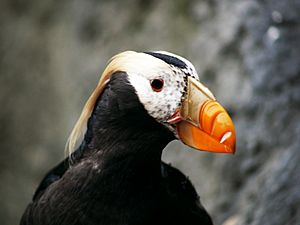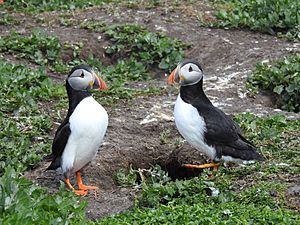Puffin facts for kids
Quick facts for kids Puffin |
|
|---|---|
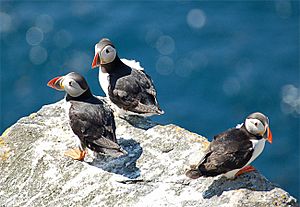 |
|
| Atlantic puffins (F. arctica) | |
| Scientific classification | |
| Type species | |
| Alca arctica Linnaeus, 1758
|
|
| Species | |
|
F. arctica |
|
| Synonyms | |
|
Lunda |
Puffins are three small species of seabirds, part of the auk family. They are famous for their brightly colored beaks, which become especially vibrant during the breeding season. These birds live mostly in the open ocean, far from land. They find their food by diving deep into the water.
Puffins gather in huge groups called colonies to breed. They make their nests on coastal cliffs or small islands. They often nest in cracks between rocks or dig burrows in the soil. Two types, the tufted puffin and horned puffin, live in the North Pacific. The Atlantic puffin lives in the North Atlantic.
All puffin species have mostly black or black and white feathers. They have a strong, stocky body and a large beak. After the breeding season, the colorful outer layers of their beaks fall off. This leaves a smaller, duller beak underneath. Their short wings are perfect for "flying" underwater to catch food. In the air, they beat their wings very fast, up to 400 times a minute. They often fly low over the ocean's surface.
Scientists are concerned about a big drop in puffin numbers in Shetland.
Contents
Puffin Family Tree
The group of birds called Fratercula was first named by a French zoologist, Mathurin Jacques Brisson, in 1760. The Atlantic puffin (Fratercula arctica) is the main species in this group. The name Fratercula comes from a Latin word meaning "little brother." This refers to their black and white feathers, which look a bit like the robes worn by monks.
The English name "puffin" originally referred to a different bird. It was used for the fatty, salted meat of young Manx shearwaters. These birds were once called "Manks puffins." The word "puffin" is an old Anglo-Norman word for these cured young birds.
There are three living species in the Fratercula group. Sometimes, the rhinoceros auklet (Cerorhinca monocerata) is also included with puffins. Some experts even put the tufted puffin in its own group called Lunda. Puffins and rhinoceros auklets are very closely related. They form a smaller bird family called Fraterculini.
Scientists believe puffins first appeared in the Pacific Ocean. This is because there are more different types of puffins there today. Only one species lives in the Atlantic, while two live in the Pacific.
Puffin Appearance
Puffins are sturdy birds with short wings and tails. Their upper bodies are black, and their undersides are white or brownish-grey. They have a black cap on their head and mostly white faces. Their feet are orange-red.
Their beaks look big and very colorful during the breeding season. But after breeding, the bright outer part of the beak sheds. This reveals a smaller, duller beak underneath.
Puffins are quite noisy when they are at their breeding colonies. However, they are silent when they are out at sea. When they fly, they usually stay about 10 meters (33 feet) above the water. Other similar birds, like auks, often fly much lower, around 1.6 meters (5 feet).
Puffin Species Details
| Species in order | |||
|---|---|---|---|
| Common and scientific names | Image | Description | Where they live |
| Atlantic puffin (Fratercula arctica) |
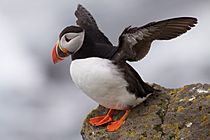 |
About 32 cm (13 inches) long, with a 53 cm (21 inches) wingspan. They weigh about 380 grams (13 ounces). | North Atlantic: from northern Europe down to northern France, the British Isles, Iceland, Norway, and Atlantic Canada. They spend winters south to Morocco and New York. |
| Horned puffin (Fratercula corniculata) |
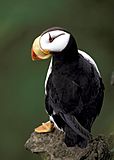 |
About 38 cm (15 inches) long, with a 58 cm (23 inches) wingspan. They weigh about 620 grams (1.4 pounds). | North Pacific: coasts of Siberia, Alaska, and British Columbia. They spend winters south to California and Baja California. |
| Tufted puffin or crested puffin (Fratercula cirrhata) |
 |
About 38 cm (15 inches) long, with a 63.5 cm (25 inches) wingspan. They weigh about 780 grams (1.7 pounds). | North Pacific: British Columbia, throughout southeastern Alaska and the Aleutian Islands. Also in Kamchatka, the Kuril Islands, and the Sea of Okhotsk. They spend winters south to Honshū and California. |
Puffin Behaviour and Life Cycle
Reproduction and Nesting
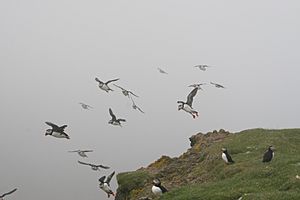
Puffins breed in large groups on coasts and islands. Many places where they breed are even named "Puffin Island." The male Atlantic puffin usually builds the nest. Puffins are very loyal to their chosen nesting spot. Both male and female horned puffins help build their nests.
Horned puffin burrows are usually about 1 meter (3.3 feet) deep. They end in a small room for the nest. Tufted puffin burrows can have tunnels up to 2.75 meters (9 feet) long. Atlantic and tufted puffins dig their tunnels in soft soil. Horned puffins, however, nest in rock crevices on cliffs. Atlantic puffin burrows are often lined with grass, leaves, and feathers.
Sometimes, Atlantic puffins will even use burrows dug by rabbits.
Puffins form strong, long-lasting pairs. The female lays just one egg. Both parents take turns sitting on the egg to keep it warm. They also both feed the chick, which is sometimes called a "puffling." The parents hold the egg close to a special warm patch on their body.
Puffin chicks leave the nest at night. After they fledge, the young puffins spend their first few years at sea. They return to land to breed when they are about five years old. Puffins in zoos have been known to breed as early as three years old.
After breeding season, all three puffin species spend the winter at sea. They usually stay far from the coast and often travel south from their breeding areas.
Iceland is home to most of the Atlantic puffins, with about 10 million birds. The largest puffin colony in the world is in the Westmann Isles of Iceland. In 2009, scientists estimated there were 1.1 million nests there. The total number of puffins in that colony could be up to 4 million.
Feeding Habits
Like many auks, puffins eat both fish and tiny sea creatures called zooplankton. However, they feed their chicks mainly small marine fish several times a day. Atlantic puffins eat fish like sandeels, herring, and capelin.
Puffins are special because they can hold many small fish at once in their beak. They carry them crosswise, sometimes more than a dozen fish! This is different from other birds that might swallow fish and then bring them back up. This skill allows puffins to go on longer hunting trips. They can bring back more food for their chick at one time. This amazing ability is possible because of a unique hinge in their beak. It allows the top and bottom parts to meet at different angles.
Puffins and Humans
Hunting and Traditions
Puffins have been hunted for their eggs, feathers, and meat. In the 1800s and early 1900s, Atlantic puffin numbers dropped a lot. This was due to hunting and changes to their homes. Today, they are still hunted in Iceland and the Faroe Islands.
On the Blasket Islands off County Kerry, Ireland, people used to hunt and eat many puffins. This was especially true before the islanders left in 1953, as food was often scarce.
In Iceland, the Atlantic puffin is part of the traditional diet. It does not have legal protection there. Puffins are hunted using a method called "sky fishing." This involves catching the birds in a large net as they dive towards the sea. Puffin meat is often found on restaurant menus. Eating the fresh heart of a puffin raw is a traditional Icelandic treat. On the small Icelandic island of Grimsey, people can catch as many as 200 puffins in a single morning.
Puffins in Culture
The name of the English island Lundy is thought to come from an old Norse word for "puffin island" (Lundey).
The Atlantic puffin is the official bird of the Canadian province of Newfoundland and Labrador.
-
Faroese stamp of 1978 showing a puffin
-
Reverse of "One Puffin" coin, Lundy 1929
-
Reverse of "Half Puffin" coin, Lundy 1929
Images for kids
See also
 In Spanish: Frailecillos para niños
In Spanish: Frailecillos para niños


